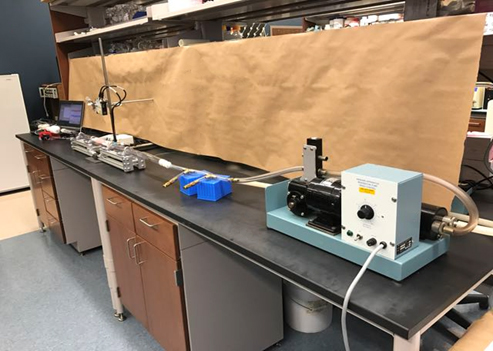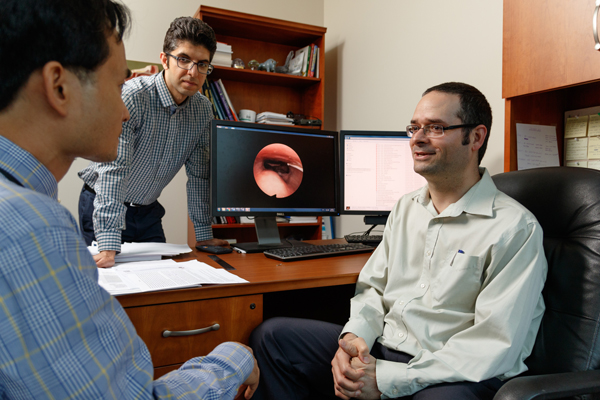Contact Us!
For more information on the Respiratory Biomechanics Laboratory, contact Dr. Guilherme Garcia.
Report a Problem
To report a problem with this website, contact BME Communications or report an accessibility issue.
Experimental Lab | Computational Lab | Institutional Resources
The Airway Biomechanics Laboratory is composed of an experimental lab and a computational lab. In addition, researchers have access to institutional resources provided by MCW's Engineering Laboratory and Research Computing Center. Together, these state-of-the-art resources ensure investigators are well-equipped to perform cutting-edge research in airway biomechanics.
 Experimental Lab
Experimental LabThe experimental laboratory space consists of approximately 65 square feet of benchtop space. The laboratory is well equipped for pressure-flow measurements in replicas of the human upper airway.
|
Flowmeters: Hans Rudolph pneumotach series 4700, TSI mass flowmeter model 4045 |
|
Pressure catheters: Millar Mikro-Cath pressure catheter |
|
Pressure transducers: Omega model #PX409-015GUSBH |
|
Pressure sensors: Validyne DP45-26-A-1-S-4-D Pressure Sensor |
|
House vacuum: House vacuum of approximately negative 25" Hg |
|
Cyclic pumps: Harvard Apparatus large-animal ventilator with tidal volume 0–50 cycles/minute |
|
Laser line scanner: Micro-Epsilon scanCONTROL 2600-100 |
|
Laptop |
 Computational Lab
Computational LabThe Computational Lab is composed of four high-performance, 12-core workstations appropriately equipped with software for fluid mechanics and solid mechanics simulations and engineering analysis.
Mimics
Mimics is the industry standard software for medical-image analysis and anatomy engineering. In the Airway Biomechanics Laboratory, Mimics is used to reconstruct anatomical models from computed tomography (CT) scans and magnetic resonance images (MRI).
ANSYS
ANSYS is a software package designed for finite element analysis (FEA), computational fluid dynamics (CFD) simulations, and fluid-structure interaction (FSI) simulations. The package used in the Airway Lab includes ANSYS SpaceClaim, ANSYS ICEM CFD, ANSYS Mechanical APDL, ANSYS Fluent, ANSYS System Coupling, ANSYS CFD-Post, and ANSYS Workbench.
Matlab
Matlab is a computing environment for data and image analysis. In the Airway Biomechanics Laboratory, Matlab is used for a wide range of applications, including to solve the differential equations of our mathematical model of airway surface liquid volume regulation.
In addition to the resources listed above, investigators in the Airway Biomechanics Laboratory enjoy access to MCW's Research Computing Center, as well as the 3D Systems ProJet 3500 HDMax 3D Printer located in MCW's Engineering Laboratory.
Research Computing Center
The Research Computing Center at MCW provides campus-wide access to high performance computing (HPC) resources required for computationally intensive biomedical research. The new state-of-art HPC environment includes 68 compute nodes, 3264 CPU cores, 28.3 TB of memory, and 24 graphical processing units (GPUs). The nodes are interconnected by 100 Gb/s Ethernet, allowing efficient parallel computing for both CPU and GPU intensive workloads. Job submission and scheduling is controlled by the Simple Linux Utility for Resource Management (SLURM).
3D System ProJet 3500 HDMax 3D Printer
The 3D Systems ProJet 3500 HDMax 3D Printer located in MCW's Engineering Laboratory has a resolution of 0.025 to 0.050 mm per 25.4 mm linear dimension. The printing material is the VisiJet M3-X print media, which results in ABS-like hard plastic.
The team at the Airway Biomechanics Laboratory is always looking for hard-working researchers with an interest in respiratory physiology and computational modeling. For more information on becoming a member of our research team, contact Dr. Garcia.